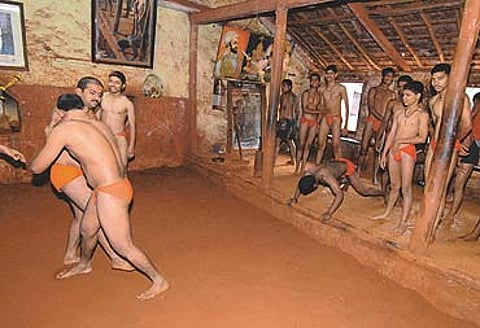The Lion's Lamb
The Marathas love their mutton—spicy, soft and rich


Only the young, muscular wrestlers swaggering around this town, which produces legendary pehelwans, can stomach the mutton bhangi rasa, steeped in ghee, laden with lavingi mirchi and guaranteed to combust on contact. Most of the talims (wrestling clubs) are in the Old City near the crowded bazaar where shop after shop sells Kolhapuri chappals. Close by is the beautifully carved historic gateway to the old palace, and the crowded Mahalaxmi temple. Outside the temple stands the statue of Khashaba Jadhav striking a victory pose—he was India's first individual Olympic medallist, winning a bronze for wrestling at the Helsinki Games in 1952. At night, the streets echo to the sounds of "Ya ho!" as the wrestlers go for dharoshna—warm, fresh buffalo milk straight from the udders and downed, glass by glass, a litre at a time. "It makes us very strong," says pehelwan Atul Ghadave. You have to see him in the akhada to believe it.
The bhangi rasa also kickstarts the jaggery-making season each November in this belt, the 'sugar-bowl' of the country. Black smoke pours out of the chimneys of gurals (jaggery houses) that dot the countryside everywhere as the bhangi rasa is prepared in large iron kayals (vats) heated by chotha (sugarcane husk). It is in these very vats that the white processed sugar of our cities makes its humble—and far more wholesome—beginning.
Kolhapur is less known—and this is a grave injustice—for its Kolhapuri missal. Pravin Phadtare runs one of Kolhapur's oldest missal houses—Phadtare Missal Centre—a makeshift hutment with enough benches to seat 50 at one go. Open only from 9 am until noon, Phadtare feeds 150 hungry patrons a Rs 15-breakfast of freshly steamed sprouts cooked with coconut and red chilli powder and garnished with chivda and onions.
But Kolhapuri mutton remains the town's signature dish, though only the wrestlers and jaggery makers now like it made the original way. "Kolhapuri cuisine is progressing toward becoming more tasteless and more insipid, like European fare," scoffs noted social historian Dr Aroon Tikekar. So if mention of Kolhapur makes you see red, that's just the stuff of cliche now.
Tags